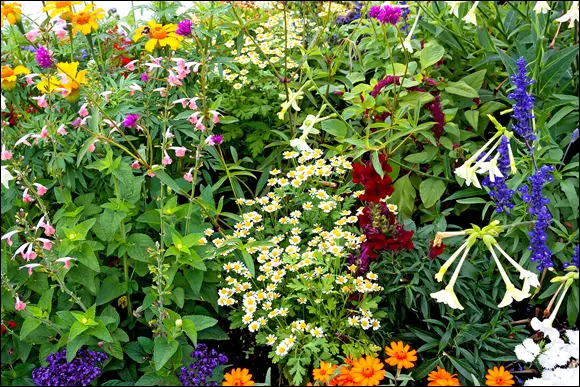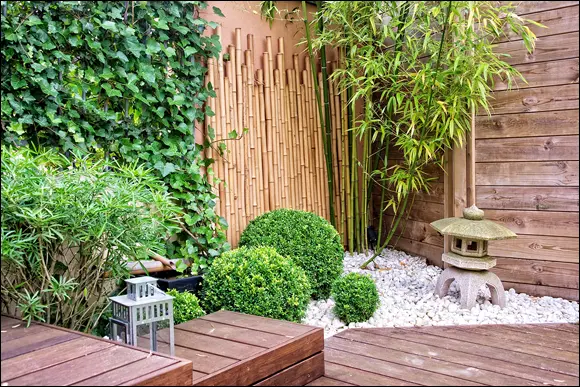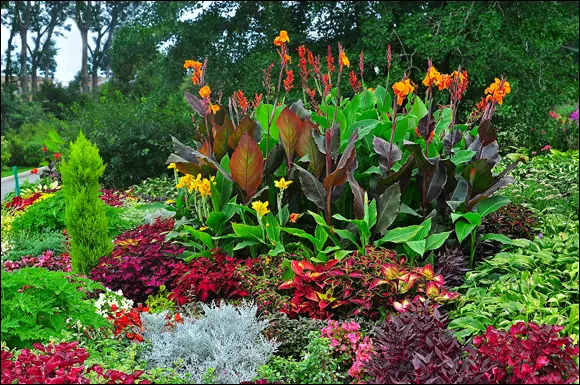Building raised beds: If the soil in the appointed spot isn’t very good, erect a raised bed from planks standing on edge. Be sure to use untreated lumber, because some wood preservatives may be harmful to edible plants. Unless you use the more expensive cedar, these wooden sides will eventually rot and need replacing. Composite lumber that is a mixture of wood fiber, plastic, and some type of binding agent is another option. These ingredients are bonded together to form a material that is denser, stronger, and heavier than wood alone and makes it extremely resistant to insect damage and rot. See Chapter 15for info on raised beds.
Installing protective barriers: If you garden in deer, woodchuck, or rabbit territory (just to name some of the worst pests), or if you host backyard soccer games, a protective fence around your kitchen garden may be in order. Use poultry wire or wood and sink it into the ground to discourage digging invaders. If the fence doesn’t look very attractive, plant fast-growing, lightweight plants to cover it, such as morning glories and moon flowers.
Planting a few containers that are literally at the kitchen door: Try a small tomato plant surrounded by ‘Spicy Globe’ basil, a cut-and-come-again mix of lettuces and salad greens, and another container of your favorite herbs.
Zeroing In on Your Ideal Garden Style
After you’ve determined your basic wants and needs for your garden space, you’re ready to decide on its overall style. Gardens come in many types, themes, and moods. Yours can be informal, with less strict boundaries, a more casual look, and a wide variety of plants; or it can be formal, with symmetrical lines, crisp edges, and a limited plant palette. Or it can be one of many variations in between.
Select a style based on the architecture of your house, the lay of the land, or even an idea you saw in a magazine or online. Your choice also ought to take into consideration the advantages and disadvantages already inherent in your yard and gardening space, as I outline in the first half of the chapter.
 A garden is an emotional place for many people — a place of pride and joy, of relaxation, comfort, and meaningful projects. It may contain favorite plants of loved ones. Luckily, a garden’s always a work in progress, and you can improve, expand, or totally change some or all of it over time. You should also be open to surprises, like the errant sunflower that pops up near the deck or the herb that self-sows into the roses and ends up looking pretty there. So, dream and plan, but be flexible. One of life’s greatest pleasures is just puttering in the garden with no particular mission in mind and discovering something new or unexpected.
A garden is an emotional place for many people — a place of pride and joy, of relaxation, comfort, and meaningful projects. It may contain favorite plants of loved ones. Luckily, a garden’s always a work in progress, and you can improve, expand, or totally change some or all of it over time. You should also be open to surprises, like the errant sunflower that pops up near the deck or the herb that self-sows into the roses and ends up looking pretty there. So, dream and plan, but be flexible. One of life’s greatest pleasures is just puttering in the garden with no particular mission in mind and discovering something new or unexpected.
Garden design often goes beyond the types of plants you want to grow and the type of function you want your garden to have. Thematic elements can also influence the look of a garden. Do you have a soft spot for old-fashioned English rose gardens? Or Japanese Zen gardens? Or even sandy deserts filled with cacti and succulents? In the following sections, I list some popular style elements to help you continue clarifying what you may want and need.
 If you want your garden to be like the styles in this book or any other of the large variety of garden styles available, be sure to do plenty of research beforehand to make your space look as harmonious and authentic as possible. And don’t forget to make sure your space can accommodate the style! Trying to install an outdoor cactus garden in the Midwest USA may not be your best bet.
If you want your garden to be like the styles in this book or any other of the large variety of garden styles available, be sure to do plenty of research beforehand to make your space look as harmonious and authentic as possible. And don’t forget to make sure your space can accommodate the style! Trying to install an outdoor cactus garden in the Midwest USA may not be your best bet.
Keep formal gardens simple (see Figure 2-1). Aim for balance and symmetry so the garden has an air of calm elegance. Here are some tips:
Use strong lines and boundaries, such as groomed hedges, walkways, perhaps even a reflecting pool.
Employ single-color plantings, aiming to match or complement your house color, fence, or another element.
Add stylish pots, urns, gazing balls, or statuary. Keep everything in moderation so it doesn’t look cluttered.

© John Wiley & Sons, Inc.
FIGURE 2-1:Annuals come in many different shapes and colors.
Japanese gardens (refer to Figure 2-2) are usually based on a garden floor, or a broad area of raked sand or stones. Choose fine-textured traditional plants, in pots or in the ground. Try bamboo, dwarf conifers, Japanese maples, iris, azalea, and flowering fruit trees. Then include Asian-style accessories such as stone lanterns, bamboo fencing, a water basin, or even a small tea house. When you choose plants for a Japanese garden, think small. Using dwarf varieties of plants can help keep the garden in scale.
Put a piece of paradise in your own backyard. Tropical gardens (check out Figure 2-3) emphasize lots of big, bold, leafy foliage plants (such as cannas, coleus, hibiscus, and taro) in the ground or in large containers. Use bright flowers in hot colors: yellow, red, and orange, as well as bicolors. Then include a water feature, such as a pool, fountain, or stream. You can add drama with extras: birdhouses or cages, colorful pots, gazing balls, and playful or handcrafted decor and statuary.

© John Wiley & Sons, Inc.
FIGURE 2-2A delightful, relaxing Japanese garden.

© John Wiley & Sons, Inc.
FIGURE 2-3:Bold colors can create a festive, lush, sizzling, tropical feel.
Cottage gardens should be overflowing with colorful blooms, so plant these inviting, informal gardens with a generous hand. Include lots of roses and other fragrant plants (including herbs). Keep the plants well-tended (remove spent flowers and stems) but allow them to express their natural exuberance. Finally, add some charming touches — a picket fence, an arbor, whimsical birdhouses, or wind chimes.
If your area is a little on the parched side, you may want to opt for a dry climate garden. Employ a naturalistic layout, perhaps with a dry streambed or stone pathways, and choose plants that thrive in hot sun, including but not limited to cacti and succulents. Then strategically place accents of colorful or more water-needy plants in pots or in groups.
Woodland gardens, which are often shady, include groundcovers that flower as well as bulbs (for lots of spring color). For fall color, you can plant some native asters.
This garden is most practical if you already have a well-treed lot. Tall deciduous hardwoods like oaks, beeches, and maples are ideal because they provide a high canopy with diffused shade. Seek out diverse forms and colors for the larger plants, from bold hostas to lacy ferns. You can then tuck in non-plant items for color and interest, such as ornaments and garden furniture.
Читать дальше

 A garden is an emotional place for many people — a place of pride and joy, of relaxation, comfort, and meaningful projects. It may contain favorite plants of loved ones. Luckily, a garden’s always a work in progress, and you can improve, expand, or totally change some or all of it over time. You should also be open to surprises, like the errant sunflower that pops up near the deck or the herb that self-sows into the roses and ends up looking pretty there. So, dream and plan, but be flexible. One of life’s greatest pleasures is just puttering in the garden with no particular mission in mind and discovering something new or unexpected.
A garden is an emotional place for many people — a place of pride and joy, of relaxation, comfort, and meaningful projects. It may contain favorite plants of loved ones. Luckily, a garden’s always a work in progress, and you can improve, expand, or totally change some or all of it over time. You should also be open to surprises, like the errant sunflower that pops up near the deck or the herb that self-sows into the roses and ends up looking pretty there. So, dream and plan, but be flexible. One of life’s greatest pleasures is just puttering in the garden with no particular mission in mind and discovering something new or unexpected.













